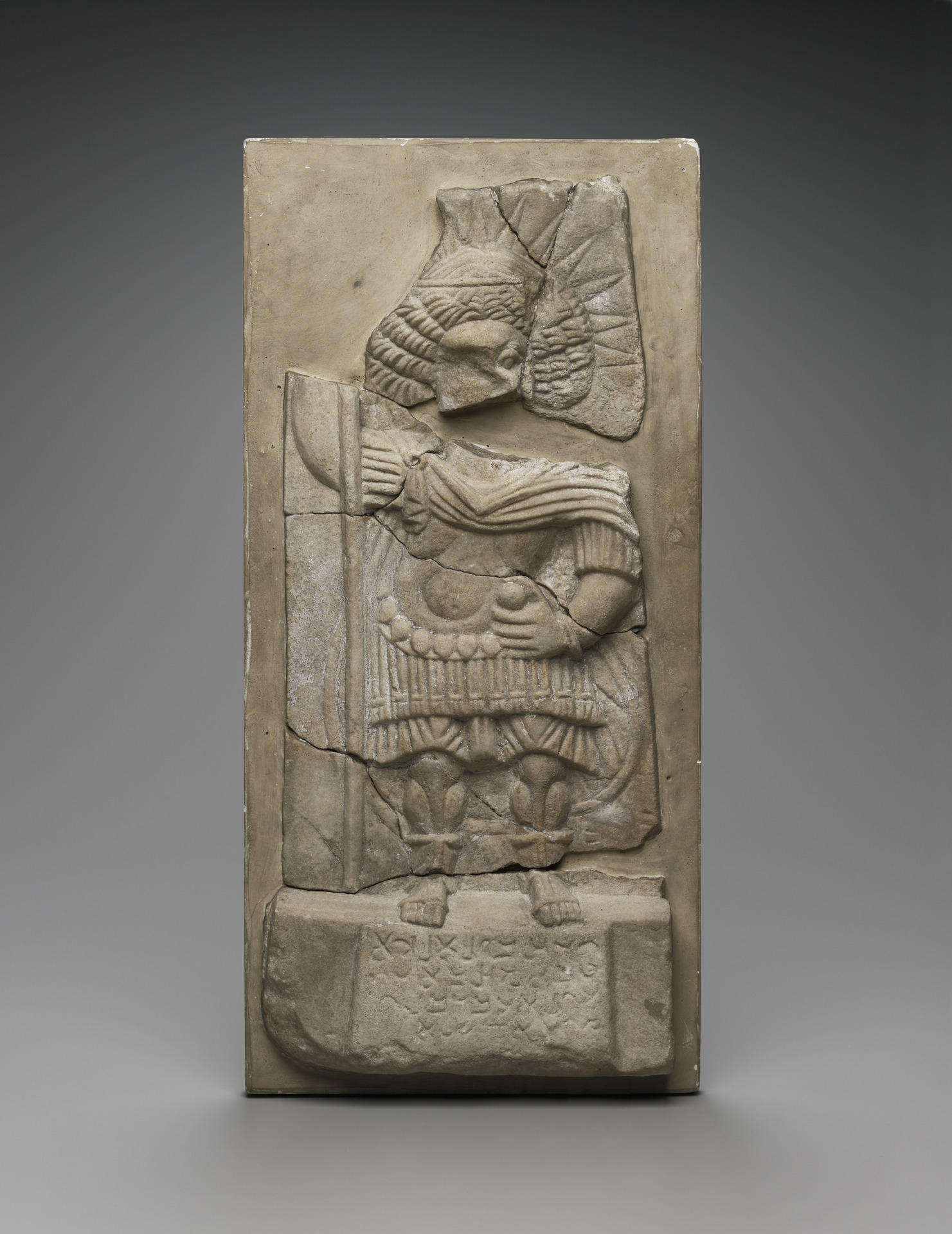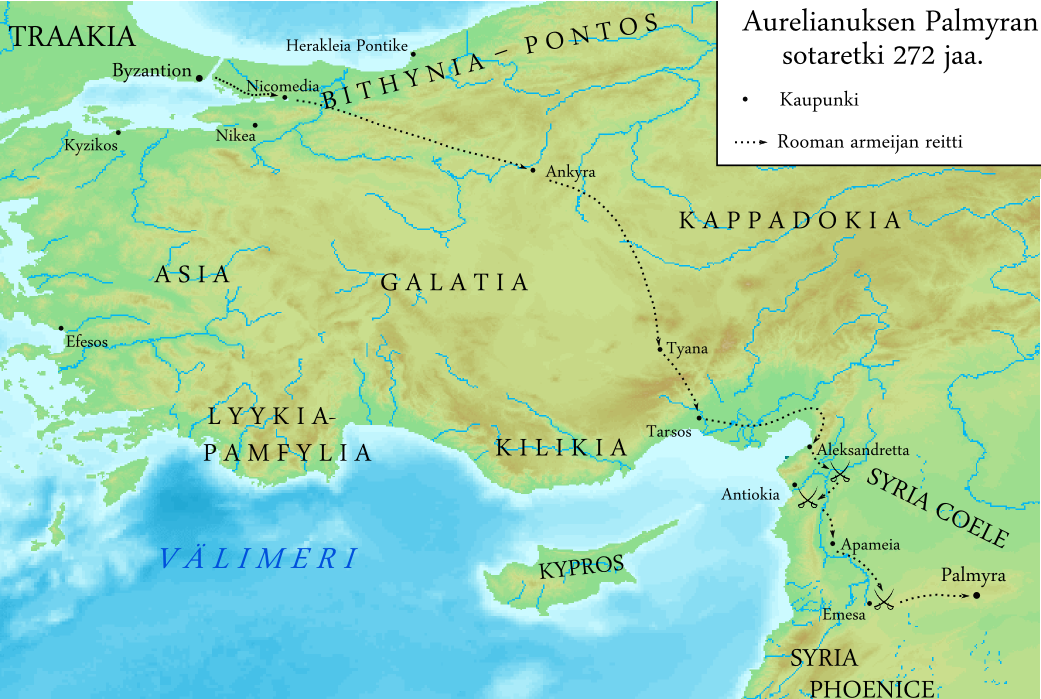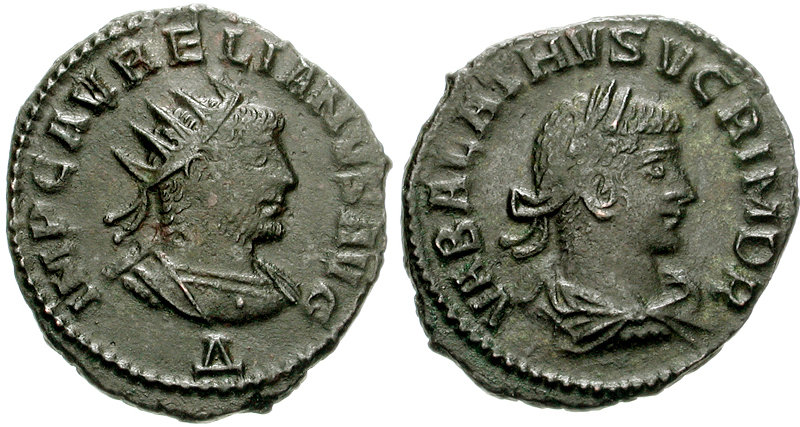|
Malak-bel
Malakbel (Palmyrene Aramaic 𐡬𐡫𐡪𐡡𐡫 ) was a sun god worshipped in the ancient Syrian city of Palmyra, frequently associated and worshipped with the moon god Aglibol as a party of a trinity involving the sky god Baalshamin. Etymology Malakbel's name means "Messenger of Baal", attesting to his mythological role as Bel's messenger and acolyte. Archaeological evidence The earliest known mention of Malakbel was an inscription which dates back to 17 BC and associates him with the lunar god Aglibol. Several other inscriptions made by the Bene Komare also associate him with Aglibol, including a bilingual inscription from 122 AD in which Aglibol and Malakbel sponsor a citizen by the name of Manai for his piety. Attestations of Malakbel's worship can be found in Rome, and as far as the province of Numidia in north Africa, as attested by a circa 178 AD inscription in the town of El Kantara, where Palmyrene archers were stationed. Sanctuaries In Palmyra Several second ... [...More Info...] [...Related Items...] OR: [Wikipedia] [Google] [Baidu] |
Bel (mythology)
Bêl (; from ) is a title signifying 'lord' or 'master' applied to various gods in the Mesopotamian religion of Akkad, Assyria, and Babylonia. The feminine form is ''Bêlit'' ('Lady, Mistress') in Akkadian. ''Bel'' is represented in Greek as Belos and in Latin as Belus. ''Belit'' appears in Greek form as Beltis (Βελτις). Linguistically, ''Bel'' is an East Semitic form cognate with the Northwest Semitic Baal with the same meaning. ''Bel'' was especially used for the Babylonian god Marduk in Assyrian and neo-Babylonian personal names or mentioned in inscriptions in a Mesopotamian context. Similarly, ''Bêlit'' mostly refers to Marduk's spouse Sarpanit. Marduk's mother, the Sumerian goddess often referred to in the Sumerian language as Ninhursag, Damkina, and Ninmah, was often known as ''Belit-ili'' ('Lady of the Gods') in Akkadian. Other gods called "Lord" were sometimes identified totally or in part with Bel Marduk. The god Malak-bel of Palmyra is an exampl ... [...More Info...] [...Related Items...] OR: [Wikipedia] [Google] [Baidu] |
Cypress
Cypress is a common name for various coniferous trees or shrubs from the ''Cupressus'' genus of the '' Cupressaceae'' family, typically found in temperate climates and subtropical regions of Asia, Europe, and North America. The word ''cypress'' is derived from Old French ''cipres'', which was imported from -4; we might wonder whether there's a point at which it's appropriate to talk of the beginnings of French, that is, when it wa ... ''cipres'', which was imported from Latin ''cypressus'', the latinisation of the Greek language">Greek κυπάρισσος (''kyparissos''). The name derives from Cyparissus, a mythological figure who was turned into a tree after killing a stag. Description Cypress trees typically reach heights of up to and exhibit a pyramidal form, particularly in their youth. Many are characterised by their needle-like, evergreen foliage and acorn-like seed cones. Some species develop flattened, spreading heads at maturity, while certain variants may manife ... [...More Info...] [...Related Items...] OR: [Wikipedia] [Google] [Baidu] |
Messenger Gods
Messenger, Messengers, The Messenger or The Messengers may refer to: People * Courier, a person or company that delivers messages, packages, or mail * Messenger (surname) * Bicycle messenger, a bicyclist who transports packages through cities * Messenger-at-arms, an officer of the Scottish Court of Session * Messenger of the Court, a court officer responsible for carrying communications and executing other orders * Prophets and messengers in Islam * Muhammad and other prophets in Islam, who were known as Messengers of Allah (God) Science and technology Biology and chemistry * Chemical messenger, such as a hormone or neurotransmitter, a molecule used for cellular signalling * Messenger RNA (mRNA), RNA that carries information from DNA to the ribosome sites of protein synthesis in a cell Electronics and computing *Instant messenger, a tool for online text communication **Facebook Messenger, an instant messaging service by Meta (Facebook) **Microsoft Messenger service, an instant ... [...More Info...] [...Related Items...] OR: [Wikipedia] [Google] [Baidu] |
Solar Gods
Solar may refer to: Astronomy * Of or relating to the Sun ** Solar telescope, a special purpose telescope used to observe the Sun ** A device that utilizes solar energy (e.g. "solar panels") ** Solar calendar, a calendar whose dates indicate the position of the Earth on its revolution around the Sun ** Solar eclipse, an eclipse of a sun in which it is obstructed by the moon ** Solar System, the planetary system made up by the Sun and the objects orbiting it * Solar Maximum Mission, a satellite * SOLAR (ISS), an observatory on International Space Station Music * "Solar" (composition), attributed to Miles Davis * ''Solar'' (Red Garland album), 1962 * ''Solar'' (Taeyang album), 2010 * ''Solar'', a 2011 album by Rubik * "Solar", a song by Northlane from '' Mesmer'', 2017 * "Solar", a song by Sault from ''Air'', 2022 * ”Solar”, a song by Stam1na from '' Taival'', 2018 * SOLAR Records, a record label Geography * Solar (Spanish term), a type of urban site * Solar, Coun ... [...More Info...] [...Related Items...] OR: [Wikipedia] [Google] [Baidu] |
West Semitic Gods
West is one of the four cardinal directions or points of the compass. It is the opposite direction from east and is the direction in which the Sun sets on the Earth. Etymology The word "west" is a Germanic word passed into some Romance languages (''ouest'' in French, ''oest'' in Catalan, ''ovest'' in Italian, ''vest'' in Romanian, ''oeste'' in Spanish and Portuguese). As in other languages, the word formation stems from the fact that west is the direction of the setting sun in the evening: 'west' derives from the Indo-European root ''*wes'' reduced from ''*wes-pero'' 'evening, night', cognate with Ancient Greek ἕσπερος hesperos 'evening; evening star; western' and Latin vesper 'evening; west'. Examples of the same formation in other languages include Latin occidens 'west' from occidō 'to go down, to set' and Hebrew מַעֲרָב (maarav) 'west' from עֶרֶב (erev) 'evening'. West is sometimes abbreviated as W. Navigation To go west using a compass for navigati ... [...More Info...] [...Related Items...] OR: [Wikipedia] [Google] [Baidu] |
Yarhibol
Yarhibol or Iarhibol is an Aramean god who was worshiped mainly in ancient Palmyra, a city in central Syria. He was depicted with a solar nimbus and styled "lord of the spring". He normally appears alongside Bel, who was a co-supreme god of Palmyra, and Aglibol, one of the other top Palmyrene gods. Origins It is believed that Yarhibol was originally the patronus/genius loci of the source Efqa in Palmyra; it is known that his title was "Lord / Guardian adof the Source". In general, however, his onomastics indicates an earlier connection with the lunar, not the solar, cult. His name translates as "the moon of Bel", and at the same time shows a connection with the North-Western Semitic ( Canaanite) moon god Jarih (Yariḫ). It is characteristic that on the stele in Dura Europos (2nd century AD), apart from the radiant crown, it is additionally decorated with a crescent. Earlier Yarhibol must have been a local deity of ancestors in a desert oasis, worshiped by the descendants o ... [...More Info...] [...Related Items...] OR: [Wikipedia] [Google] [Baidu] |
List Of Solar Deities
A solar deity is a god or goddess who represents the Sun, or an aspect of it, usually by its perceived power and strength. Solar deities and Sun worship can be found throughout most of recorded history in various forms. The following is a list of solar deities: African Bakongo mythology * Nzambi Mpungu, Kongo god of the Sun and creation Bantu mythology * Nyambe, the Bantu god of the Sun and creation Berber/Amazigh mythology * Magec, Tenerife goddess of the Sun and light Igbo mythology * Anyanwu, Igbo god believed to dwell in the Sun Dahomey mythology * Mawu, Dahomey goddess associated with the Sun and the Moon Egyptian mythology * Amun, creator deity sometimes identified as a Sun god * Aten, god of the Sun, the visible disc of the Sun * Atum, the "finisher of the world" who represents the Sun as it sets * Bast, cat goddess associated with the Sun * Hathor, mother of Horus and Ra and goddess of the Sun * Horus, god of the sky whose right eye was consid ... [...More Info...] [...Related Items...] OR: [Wikipedia] [Google] [Baidu] |
Capena
Capena (until 1933 called Leprignano) is a town and ''comune'' in the Metropolitan City of Rome, Lazio region (central Italy). The town has borrowed its modern name from a pre-Roman and Roman settlement that was to its north. Geography Capena is located north of Rome (as the crow flies), above the valley of the Tiber. The old quarter stands on a hill overlooking the valley of the Fosso di Morlupo to the west, while the modern district extends into the eastern plain. The neighbouring towns are Castelnuovo di Porto, Civitella San Paolo, Fiano Romano, Monterotondo, Morlupo and Rignano Flaminio. History Ancient era The original Capena occupied the plateau of a nowadays uninhabited hill called La Civitucola, which is about northeast of a post station on the ancient ''Via Flaminia''. Its territory was known in ancient times as the ''Ager Capenas'', which was a Faliscan area adjacent (and culturally allied) to Etruria. It is frequently mentioned alongside of Veii, Falerii an ... [...More Info...] [...Related Items...] OR: [Wikipedia] [Google] [Baidu] |
Elagabalus (deity)
Elagabalus (), Aelagabalus, Heliogabalus () or simply Elagabal (Aramaic alphabet, Aramaic: 𐡀𐡋𐡄𐡀𐡂𐡁𐡋 ''ʾĕlāhaʾgabāl'') was an Ancient Semitic religion, Arab-Roman mythology, Roman sun god, initially venerated in Emesa (modern-day Homs), Syria. Although there were many variations of the name, the god was consistently referred to as ''Elagabalus'' in Roman coins and inscriptions from AD 218 on, during the reign of Emperor Elagabalus. Cult Elagabalus was initially venerated at Emesa in Syria, where the Arab Emesan dynasty acted as its priests. The name is the Latinisation of names, Latinised form of the Arabic "''Ilah al-Jabal''" ("إله الجبل"), the Emesene manifestation of the deity, which is Arabic for "God of the Mountain." Elagabalus was the religious "lord", or Ba'al, of Emesa. The deity successfully preserved Arab characteristics, both in his names and representations. The cult of the deity spread to other parts of the Roman Empire in the secon ... [...More Info...] [...Related Items...] OR: [Wikipedia] [Google] [Baidu] |
Aurelian
Aurelian (; ; 9 September ) was a Roman emperor who reigned from 270 to 275 AD during the Crisis of the Third Century. As emperor, he won an unprecedented series of military victories which reunited the Roman Empire after it had nearly disintegrated under the pressure of barbarian invasions and internal revolts. Born in modest circumstances, most likely in Moesia, Moesia Superior, he entered the Roman army in 235 and climbed up the ranks. He went on to lead the cavalry of the emperor Gallienus, until Gallienus' Gallienus#Assassination, assassination in 268. Following that, Claudius Gothicus became emperor until his own death in 270. Claudius' brother Quintillus then ruled for three months, before Aurelian took the empire for himself. Aurelian was chosen Roman emperor by the Illyrians, Illyriciani as one of themselves. During his reign, he defeated the Alamanni after a devastating war. He also defeated the Goths, Vandals, Juthungi, Sarmatians, and Carpi (people), Carpi. Aurelian ... [...More Info...] [...Related Items...] OR: [Wikipedia] [Google] [Baidu] |
Palmyrene Empire
The Palmyrene Empire was a short-lived breakaway state from the Roman Empire resulting from the Crisis of the Third Century. Named after its capital city, Palmyra, it encompassed the Roman provinces of Syria Palaestina, Arabia Petraea, and Egypt (Roman province), Egypt, as well as large parts of Anatolia, Asia Minor. The Palmyrene Empire was ruled by Queen Zenobia, officially as regent for her son Vaballathus, who inherited the throne in 267 at age ten. In 270, Zenobia rapidly conquered most of the Roman east, attempting to maintain relations with Rome as a legitimate power. In 271, she claimed the imperial title for both herself and her son, fighting a short war with the Roman emperor Aurelian, who conquered Palmyra and captured Zenobia. A year later the Palmyrenes rebelled, which led Aurelian to raze Palmyra. Despite its brief existence, the Palmyrene Empire is remembered for having been ruled by one of the most ambitious and powerful women in antiquity. It is also hailed in mo ... [...More Info...] [...Related Items...] OR: [Wikipedia] [Google] [Baidu] |
Sol Invictus
Sol Invictus (, "Invincible Sun" or "Unconquered Sun") was the official Solar deity, sun god of the late Roman Empire and a later version of the god Sol (Roman mythology), Sol. The emperor Aurelian revived his cult in 274 AD and promoted Sol Invictus as the chief god of the empire. From Aurelian onward, Sol Invictus often appeared on imperial coinage, usually shown wearing a sun crown and driving a horse-drawn chariot through the sky. His prominence lasted until the emperor Constantine the Great, Constantine I legalized Christianity and restricted paganism. The last known inscription referring to Sol Invictus dates to AD 387, although there were enough devotees in the fifth century that the Christian theologian Augustine of Hippo, Augustine found it necessary to preach against them. In recent years, the scholarly community has become divided on Sol between traditionalists and a growing group of revisionists. In the traditional view, ''Sol Invictus'' was the second of two dif ... [...More Info...] [...Related Items...] OR: [Wikipedia] [Google] [Baidu] |






